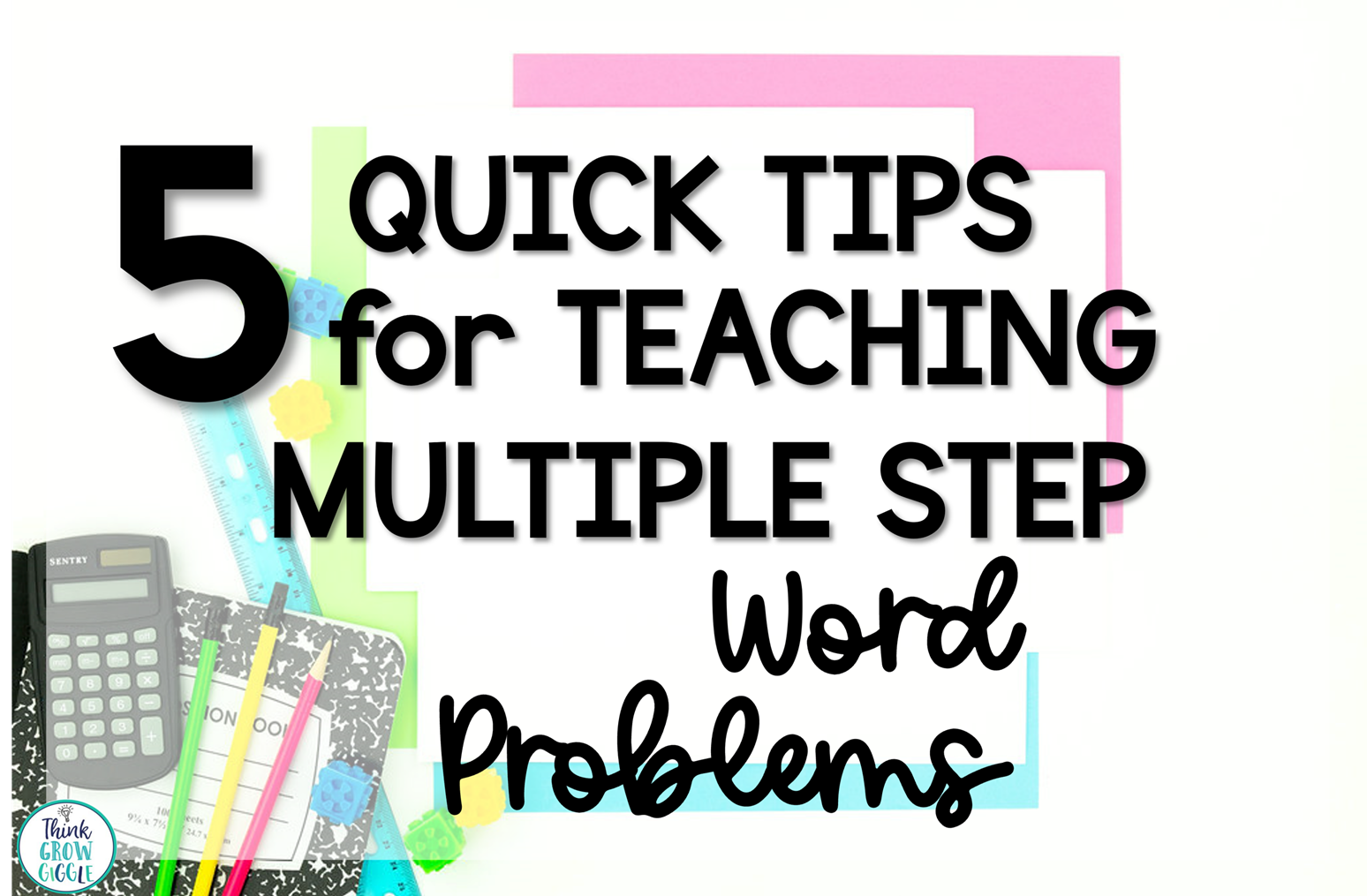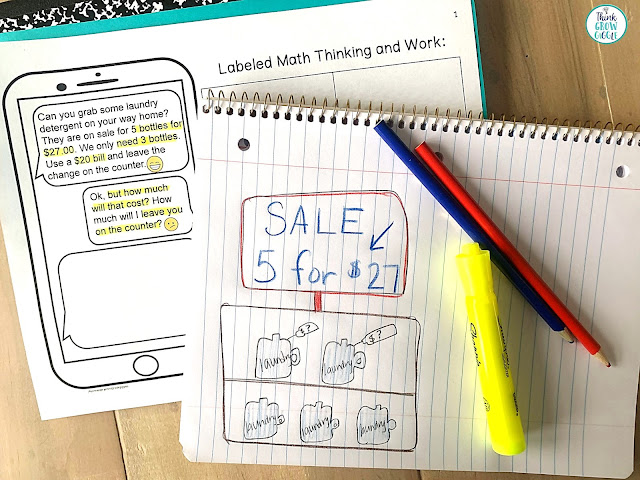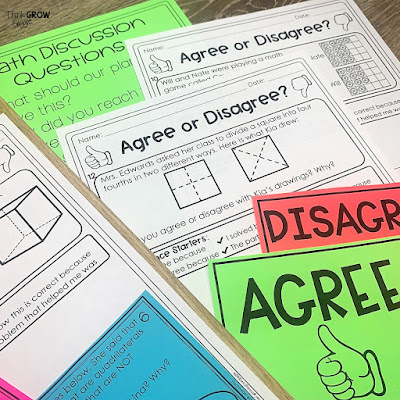 |
If your students are like mine, you have at least a few who would be willing to give up the seat next to their best friend at lunch just to avoid math word problems. Sometimes even students with solid computation skills struggle with word problems. There are more than a few scripted methods for problem-solving with catchy acronyms, but they don’t always work for certain types of problems, making it frustrating for both students and teachers.
Luckily, there are some tried and true tips that can help students persevere while solving complex word problems and even begin to love math word problems. Here are 5 tips you can use with your students tomorrow for any problem
students may encounter. Problem solved, lunch seat saved!
1. Turn the Frown Upside Down
If there is any possible way to make the word problems feel more like freshly baked cookies than canned dog food, do that first. Many students think word problems are boring or unrelatable. Perhaps you have to use the math curriculum as mandated by your district. Make that curriculum work for you and your kids, by letting students use the same numbers from the book's problems, but work in pairs to write their own scenario that’s more interesting for your students. Students can use topics related to their interests, current school events happening like a fall festival, or something related to an upcoming local sporting event. After a few practice rounds together, your students will enjoy coming up with problems on their own.
My students love creating word problems with partners. It is a great way to engage in meaningful math discourse. Don’t have time to recreate the wheel? My students love these “Text Me” math problems and enjoy “texting” back the answers. They love them and do not even realize they are doing multiple step problem solving!
2. Embrace the Struggle
Acknowledge
that some math problems are going to be difficult. Remind your students that
they can do hard things and that it’s okay to make mistakes and learn from
mistakes on the way. Point out and celebrate students who don’t necessarily get
answers correct, but who do take risks or try a new way of approaching a
problem. When students feel safe to take a risk, they are more willing to try
out the scary word problem in the first place. This also lets your proficient
students know there is more to math than getting correct answers. Being able to
approach problems flexibly and explain your thinking are essential skills for
math success too.
Teach
your students about growth mindset and what stamina means and practice working on word problems for
increasing lengths of time. Start each day with a difficult word problem. At first, you will be doing most of the work through modeling, thinking aloud, and calling on a student or two to help. Slowly lessen the work you do and increase the work that the students do. You will see a HUGE change in students in just two weeks. The more students practice this with the whole class, the easier it will
be for them to stick with a tough problem independently rather than just giving up.
Want to try it out? Grab these math goodies below to get started: Motivating poster, multiple step word problems, and math discussion stems to get all students actively engaged in the lesson!
3. Read and Restate
Imagine a friend texted you for help
figuring out how much cocoa to buy for the hot chocolate fundraiser you’re both
helping with. Before you reply you need to make sure you understand what she’s
asking about. If you didn’t even know there was a fundraiser, you’d be pretty
lost.
A
trick to help students make sure they really understand a problem is to have
them read it, then flip their page over or cover it up. Next, turn to a partner
and in their own words explain the situation. They don’t need to remember exact
numbers. The important part is they know what the problem is about and what
they need to figure out. If students cover their page and aren’t sure what the
problem is about, it’s a good idea to reread as many times as needed. Encourage
students to ask questions in order to better understand what they need to do.
Once students know exactly what the problem is asking they can get to work on highlighting or circling the important numbers in the problem, create a plan to solve it and persevere until they have a solution that matches the problem.
4. Make it Visual
Many of my students are visual learners and need more than just words to make sense of a problem. And sometimes manipulatives can cause more confusion and distraction than necessary when it comes to solving multiple-step word problems. That is why I love to have students visualize the math word problems that they read. We go one step further and create a sketch or illustration of the word problem in their math notebooks. By bringing reading strategies into math, students understand that math word problems are about comprehension first, mathematics second.
In this problem, drawing a picture truly helps students to understand that they need to find the price of one laundry detergent bottle so that they can find the total of the three bottles that they need to buy. By creating a quick sketch of a store shelf it is clear that they do not know the cost of one bottle. Each bottle is drawn with a question mark for a price tag. This student now knows their first step is to divide $27 by five bottles.
5. Check & Correct...Try something different!
Finally,
to ensure all that hard work pays off, students must check their work for
accuracy and correct any errors. One tip my students love is to work backward.
That way they are performing the opposite operation and are less likely to make
the same mistake twice or just gloss over their work. Students can also solve
the same problem in a new way. This reinforces the idea that there are multiple
valid ways to arrive at a correct answer.
Before
turning in any work, students should ask themselves the following:
● Does my response answer all of the
questions in this problem?
● Does the answer make sense?
Whether
you’re a seasoned teacher or just getting started, your students will
appreciate your thoughtful approach to multiple-step problem-solving. Even if
you already have a system for teaching word problems, you can incorporate these
ideas into your teaching to build confidence, grow stamina, and develop a love
for learning while tackling the toughest problems.
Get
started now with these Text Me MathProblems that will get your students excited to jump in and start learning!

















